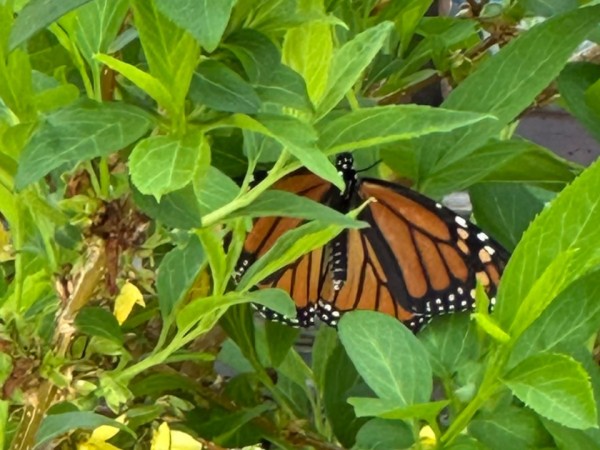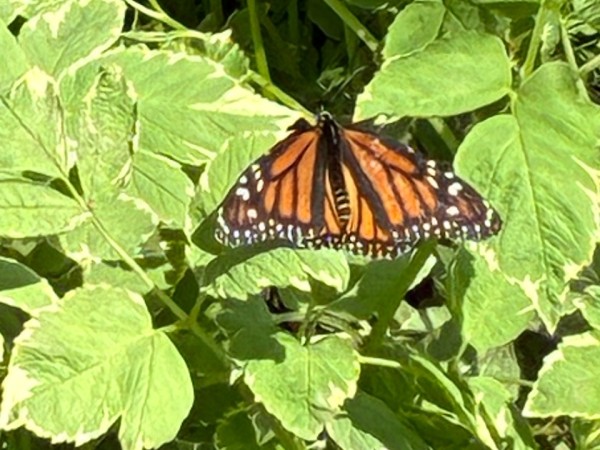Monarch migration reaches Michigan, New York, and more
Eastern monarch update
By Jacob Swanson, Journey North
Last year, we received just one report from central New York before the calendar switched to June, but it would prove to be an outlier. This year, we’ve already doubled that, with sightings from Cortland and Ithaca, and we’re anxiously waiting to see if it’s a similar case to last year, or if more sightings will flow in over the next two weeks.
“About two months too early for our area,” wrote Steven in Cortland on May 10. “My milkweeds (A. tuberosa, A. exaltata, A. syriaca, and A. purpurascens) have not emerged from the ground yet.” You can see Steven's photo at the top of the update.
In Cheektowaga, New York, near Buffalo, Ray reported one adult on May 12 as well, writing, “Not sure what they are going to eat!”
It won’t help adult monarchs, which rely on nectar for sustenance, but there should at least be milkweed available for laying eggs, with a report of milkweed over 200 miles north, in Corbeil, Ontario. Teresa submitted the report on May 10.
Across Lake Ontario, in Toronto, Jackie submitted Canada’s first Journey North monarch report of the year on May 13.
Moving to Michigan and more
Over the past few weeks, we’ve also received our first reports from Nebraska, Minnesota, and New Hampshire, though we don’t have any photos yet.
We’ve received several photos from southeastern Michigan. In Ann Arbor, Grant wrote on May 7, “Saw this lovely monarch this morning! Definitely excited to see more,” with Wendy in Flat Rock submitting a photo of a female on May 5 as well.
Jocelyn in Rochester Hills reported 19 eggs on May 12, writing, “This is the earliest I have ever seen eggs. Hopefully it’s a sign of a good season to come.”
Larvae have been reported from the Indianapolis and Washington, D.C., areas.
“I was very surprised to see that I had been visited recently and just noticed the 2/3 instar caterpillars on Wed., April 30,” wrote Meg in Ashburn, Virginia. “Earliest I have seen them in a while.”
In Purcellville, Virginia, Marty reported 10 caterpillars on May 4, writing, “The milkweed is established from last year. First time seeing caterpillars in my garden.”
Below the leading edge
It’s not just those on the leading edge of migration that are enjoying the monarchs’ presence, however.
“It is the first one I have seen this year. Normally by this time I would have seen many monarchs, eggs, and caterpillars,” wrote Christine in Fort Worth, Texas, on May 10. “They would have moved on by now. So happy that I get to see at least one.”
“Finally spotted a monarch in my garden this morning,” wrote Emily in Gastonia, North Carolina, on May 4. “Hoping she is busy busy laying eggs, as the milkweed is tall and ready to support lots of caterpillars.”
Western monarch update
By Gail Morris, Southwest Monarch Study coordinator
Southern California continues to report monarch sightings and larvae as the breeding season continues favorably. But eyes turn to the north and east to watch for sights of monarchs on their spring migration throughout the West.
Western monarch sightings
We enter May, waiting in parts of the West for the first sighting of monarchs arriving. Northern California and Arizona, as well as Nevada and Utah, traditionally see their first monarchs this month. Late cold weather and storm systems rolling through naturally slow their movement, but warm, sunny days help their flight.
In late April, Jacques reported his first monarch in Willow Creek, California: “First Monarch. Flying. Earlier than I have ever seen. Milkweed is 100 feet away and all along the river bar.”
It would be great if someone could get a photo of a monarch to document this early arrival. Let’s hope we see one soon. Meanwhile, Tracey reported a monarch in Mesa, Arizona on Desert Milkweed, also known as Rush Milkweed (A. subulata). The cooler weather in Arizona likely kept the monarchs in the lower deserts last week, but a warm-up could open the gateway to the higher elevations.
Diana Magor in Santa Cruz, California, said she just tagged two freshly eclosed monarchs from her yard the week before last, but had not seen any other monarchs visit. “Amend that earlier statement about no monarchs around....1 just flew over my home garden potted waystation!”
Western milkweed up
Is milkweed up? Is it flowering? Females often lay eggs on milkweed just breaking ground, but benefit from nectar resources nearby to recharge their energy. It’s not unusual to find monarch eggs or larvae without a first sighting, as females move quickly through milkweed patches on their way to their summer breeding grounds. For many places in the West, now it’s a waiting game for their arrival.
Thank you to everyone who reported their first sightings of milkweed up! Milkweed is thriving and waiting in California. Sparks, Nevada, is also finding milkweed breaking ground. In Castle Valley, American Fork and Ogden, Utah, milkweed is up and ready. Even Eileen in Boise, Idaho, reported on April 27, “My backyard Showy Milkweed is up.”
Keep your eyes on your milkweed patch!
Monarch and milkweed sightings wanted
Do you see milkweed up? Are you lucky enough to see any monarchs this Spring? Send in your sightings to help us present a balanced report of where monarchs are appearing each week. Report adult monarchs, eggs, and larvae to Journey North weekly. Your detailed description of what you see can include, but is not limited to, the monarch’s gender and activity. If known, include the type of flowers if they are nectaring or milkweed type if laying eggs. Photos are encouraged and welcomed with all your reports.
Gail Morris is the coordinator of the Southwest Monarch Study (www.swmonarchs.org). She is also a Monarch Watch conservation specialist, the vice president of the Central Arizona Butterfly Association and participates in several western monarch working groups. The Western Monarch News is based on comments provided to Gail Morris. We hope to increase the number of sightings and, therefore, photos and comments entered into Journey North. We rely on the volunteers who communicate regularly with Gail and who agree to participate in our effort to increase awareness of the population of western monarchs. You can reach her at gail@swmonarchs.org












